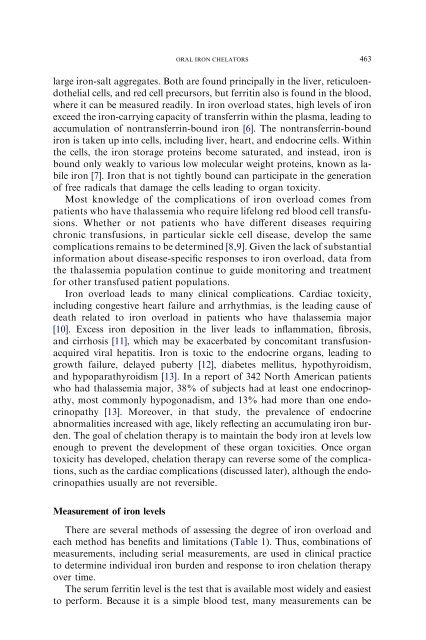Pediatric Clinics of North America - CIPERJ
Pediatric Clinics of North America - CIPERJ
Pediatric Clinics of North America - CIPERJ
Create successful ePaper yourself
Turn your PDF publications into a flip-book with our unique Google optimized e-Paper software.
ORAL IRON CHELATORS<br />
463<br />
large iron-salt aggregates. Both are found principally in the liver, reticuloendothelial<br />
cells, and red cell precursors, but ferritin also is found in the blood,<br />
where it can be measured readily. In iron overload states, high levels <strong>of</strong> iron<br />
exceed the iron-carrying capacity <strong>of</strong> transferrin within the plasma, leading to<br />
accumulation <strong>of</strong> nontransferrin-bound iron [6]. The nontransferrin-bound<br />
iron is taken up into cells, including liver, heart, and endocrine cells. Within<br />
the cells, the iron storage proteins become saturated, and instead, iron is<br />
bound only weakly to various low molecular weight proteins, known as labile<br />
iron [7]. Iron that is not tightly bound can participate in the generation<br />
<strong>of</strong> free radicals that damage the cells leading to organ toxicity.<br />
Most knowledge <strong>of</strong> the complications <strong>of</strong> iron overload comes from<br />
patients who have thalassemia who require lifelong red blood cell transfusions.<br />
Whether or not patients who have different diseases requiring<br />
chronic transfusions, in particular sickle cell disease, develop the same<br />
complications remains to be determined [8,9]. Given the lack <strong>of</strong> substantial<br />
information about disease-specific responses to iron overload, data from<br />
the thalassemia population continue to guide monitoring and treatment<br />
for other transfused patient populations.<br />
Iron overload leads to many clinical complications. Cardiac toxicity,<br />
including congestive heart failure and arrhythmias, is the leading cause <strong>of</strong><br />
death related to iron overload in patients who have thalassemia major<br />
[10]. Excess iron deposition in the liver leads to inflammation, fibrosis,<br />
and cirrhosis [11], which may be exacerbated by concomitant transfusionacquired<br />
viral hepatitis. Iron is toxic to the endocrine organs, leading to<br />
growth failure, delayed puberty [12], diabetes mellitus, hypothyroidism,<br />
and hypoparathyroidism [13]. In a report <strong>of</strong> 342 <strong>North</strong> <strong>America</strong>n patients<br />
who had thalassemia major, 38% <strong>of</strong> subjects had at least one endocrinopathy,<br />
most commonly hypogonadism, and 13% had more than one endocrinopathy<br />
[13]. Moreover, in that study, the prevalence <strong>of</strong> endocrine<br />
abnormalities increased with age, likely reflecting an accumulating iron burden.<br />
The goal <strong>of</strong> chelation therapy is to maintain the body iron at levels low<br />
enough to prevent the development <strong>of</strong> these organ toxicities. Once organ<br />
toxicity has developed, chelation therapy can reverse some <strong>of</strong> the complications,<br />
such as the cardiac complications (discussed later), although the endocrinopathies<br />
usually are not reversible.<br />
Measurement <strong>of</strong> iron levels<br />
There are several methods <strong>of</strong> assessing the degree <strong>of</strong> iron overload and<br />
each method has benefits and limitations (Table 1). Thus, combinations <strong>of</strong><br />
measurements, including serial measurements, are used in clinical practice<br />
to determine individual iron burden and response to iron chelation therapy<br />
over time.<br />
The serum ferritin level is the test that is available most widely and easiest<br />
to perform. Because it is a simple blood test, many measurements can be





